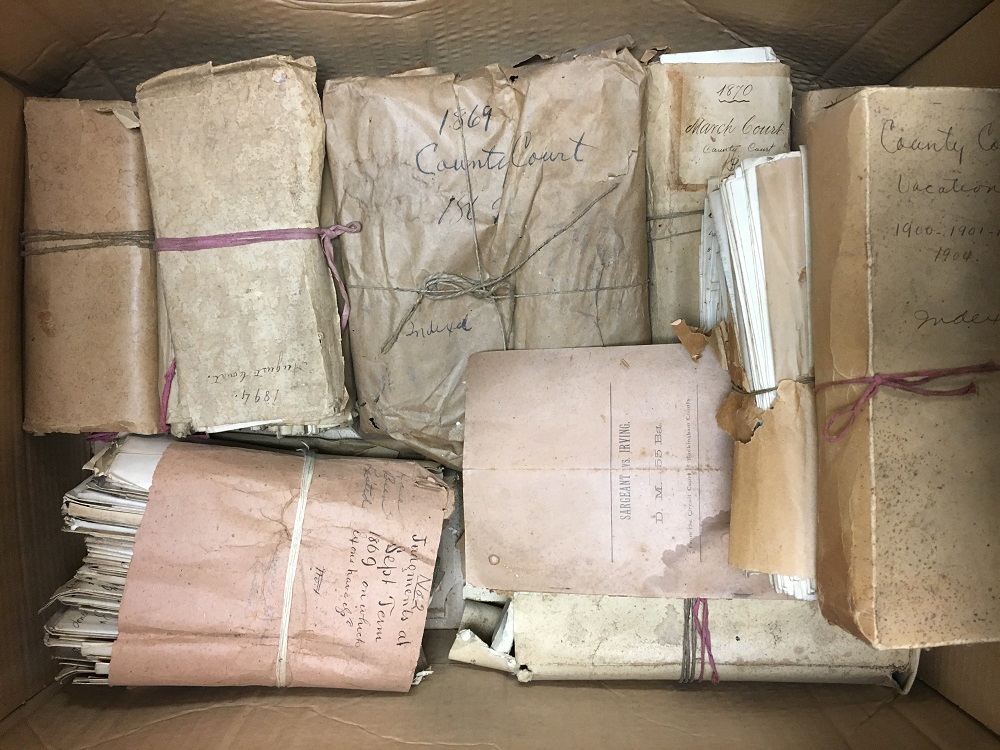A new Circuit Court Records Preservation Program (CCRP) travel season has begun, which means that CCRP consulting archivists Eddie Woodward and Tracy Harter are planning visits to courthouse records rooms to identify materials in need of conservation. It is likely that regular readers of the UncommonWealth are familiar with some of our posts and know what we do during those visits, while new readers may not be.
Below is an installment of the old-fashioned game, Concentration. You will see a grid of cards, which is comprised of 12 matching pairs. The pairs represent twelve kinds of conservation challenges that my colleague and I regularly see in the courthouses, although there are many other challenges in addition to these.
Can YOU match two cards with similar conservation problems?
Keep in mind there may be more than one problem in a photo; if so, choose the most pronounced one.
When you are finished, read the explanatory answers below the grid.
Bundles
Losses to Portions of a Leaf
Pressure Sensitive Tape
Losses and Crumpling in Pages
Bundles
Shiny, Modern Lamination
Cellulose Acetate Lamination
Detached Leaf
Insect Damage
Losses and Crumpling in Pages
Detached Leaf
“Chipped” Pages
Cellulose Acetate Lamination
Evidence of Mold
Crumpled Pages
Insect Damage
Pressure Sensitive Tape
Shiny, Modern Lamination
“Chipped” Pages
Tape-Stripped Volume
Crumpled Pages
Tape-Stripped Volume
Evidence of Mold
Losses to Portions of a Leaf
Explanatory answers:
| Bundles | While bundles of loose records are not often candidates for CCRP item conservation grants, local records archivists often conduct inventories of these kinds of records. For localities with very few volumes in need of conservation, loose records such as marriage licenses may be viable conservation candidates. |
| Cellulose Acetate | Cellulose acetate lamination was a popular conservation technique throughout much of the 20th century that has since been discredited, as it often involved sandwiching acidic paper between two layers of laminate. |
| Chipped | Paper that is brittle often suffers from easily being chipped and torn. |
| Crumpled | Crumpled pages |
| Crumpled/losses | Land books often suffer from losses and crumpling, especially in the first few pages which have received heavy use over the decades. |
| Detached leaf | A leaf consists of two sides, which we commonly call pages. So, technically there are no detached pages, but detached leaves. |
| Insect damage | Not only do insects often leave droppings, but they also often eat through paper (and cardboard!) |
| Losses | Losses can occur for a variety of reasons. |
| Modern lamination | Modern lamination differs from cellulose acetate lamination in many ways, but it is often equally difficult to remove, as its shiny plastic layer interacts with paper in ways that differ from volume to volume. |
| Mold | Mold is never good, but it can be cleaned and kept inactive in the right environmental conditions. |
| Stripped with tape | Volumes in many records rooms were cut apart and then taped to paper tabs. The tape often covers text and becomes gummy and sticky itself. |
| Pressure Sensitive Tape | This is shiny, modern tape often used as repairs (and typically over-used). It inevitably gets sticky and yellows over time, causing more damage. |






